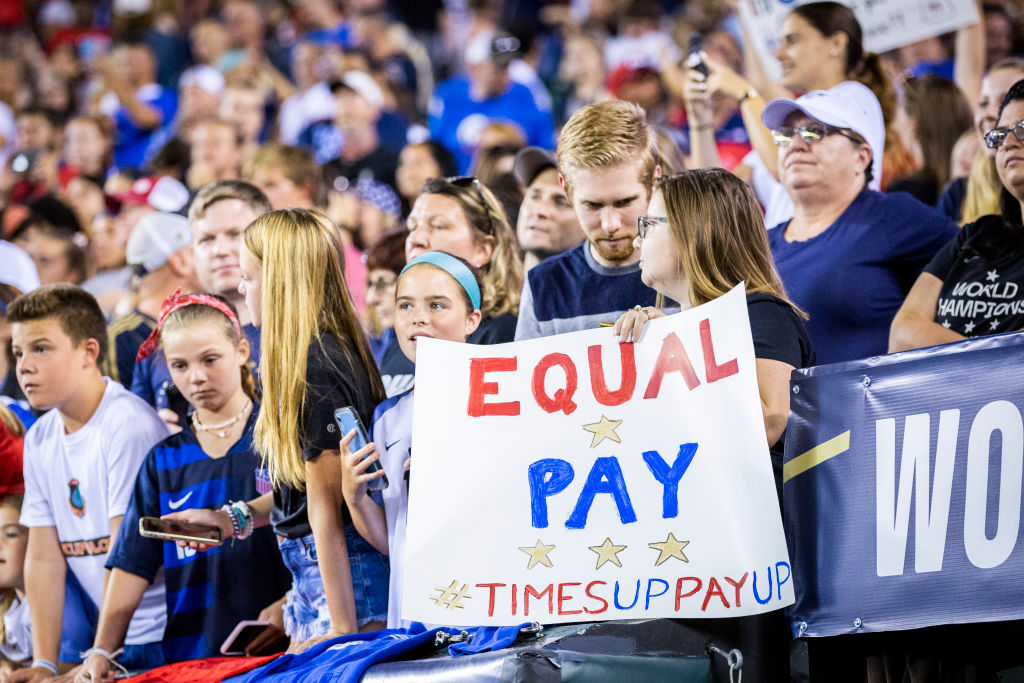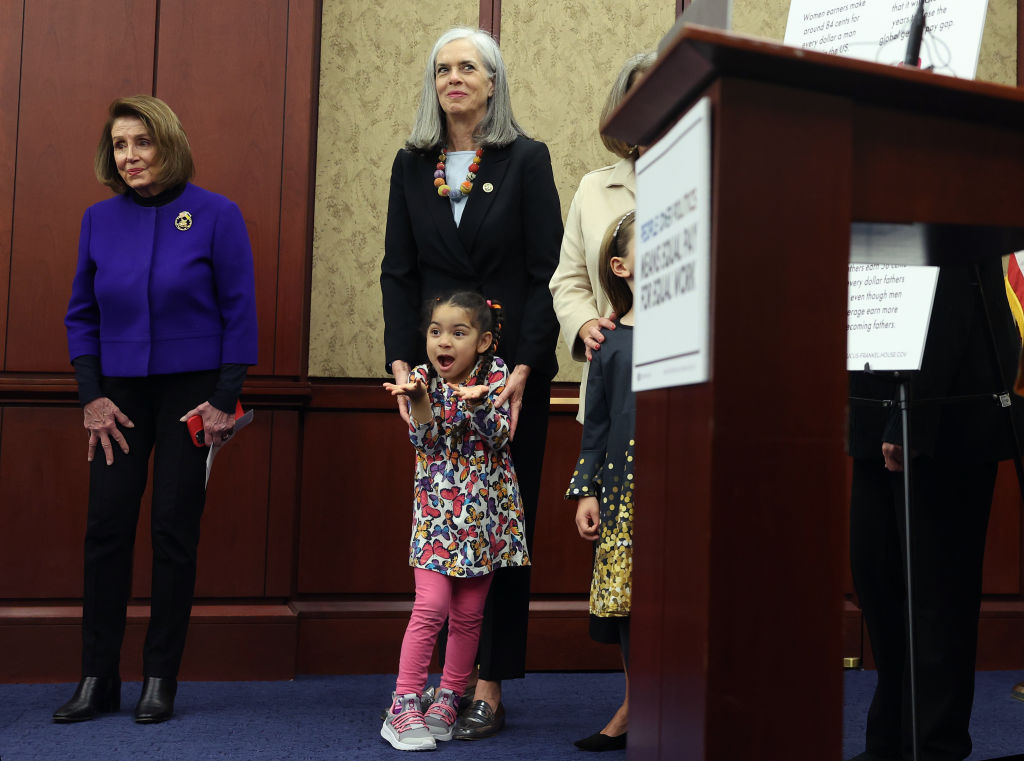No, women aren’t “choosing” lower pay—the system is rigged.
- Women now earn 75 cents on a man’s dollar, which suggests the wage gap will not be closed until 2068.
- Despite earning a 45 percent increase in real wages between 1980 and 2018, wage growth for women has declined in the last two fiscal years.
- The Sandwich Generation, middle-aged adults with both aging parents and children, remains smashed between a rock and a hard place.
- Even highly skilled women like medical doctors, especially those with children, earn significantly less than their male counterparts.
- Care work is integral to all other work, according to economist Anwesha Majumder.

The National Partnership for Women and Families reported late last year the wage gap for all women workers had widened to 75 cents for every dollar men earned, representing a 3-cent decrease in real pay per hour for women. While on the surface this may seem negligible in a paycheck, even a seemingly small increase in wage disparity dramatically impacts the significant gains in pay since the 1980s.
Even though full-time, year-round workers had a lower gap at 1 cent per hour, the Center for American Progress reports that with this current backslide, it will now take until 2068 to close the wage gap.
The news is even worse for Latinas, Indigenous women and Black women, who are paid 51, 52 and 64 cents on the dollar compared to white, non-Hispanic men, respectively. Asian and white women fared the best, at 83 cents and 73 cents respectively.
Disabled women workers have seen their wages depressed down to 45 cents on the dollar.
When the Equal Rights Amendment is finally added the Constitution at long last, enshrining equal rights for women could theoretically bolster efforts for equivalent pay.
Starting from Behind
There’s a long tail of supposed justifications of why women’s wages lag, starting with historically blocking access to meaningful employment and continuing with the old tropes of women “choosing” lower-paying fields, like education or healthcare. We are meant to forget that in positions at the highest levels of these fields, such as college presidents or hospital administrators, the pay is quite lucrative, and it is men who are more likely to hold these top posts.
While in both healthcare and education women perform 77 percent of the work, they earn less, both in the classroom and at the MD level of medicine.

In industries like tech, known for high salaries, the story can often be the same. While the divide is narrower, it is important to call out. The average tech salary of $112K annually is nearly double that of the average American salary across all industries, but just like in healthcare and education women are underpaid, on average earning $15,000 less yearly than men.
Considering that only 2.3 percent of venture funding is awarded to women, it’s even harder to imagine change coming from the C-Suite.
Lauren Buckley, founder and strategy principal of Hush Collaborative, which helps organizations apply the principles of community-building and activism to be more inclusive, pushes back hard on the idea that women self-select for lower wages by the professions or roles they choose.
“We have this paradigm where the baseline for women starts out less in terms of pay, so even good jobs seem ‘low paying’ because of the structural biases when it comes to women in the workplace, and the persistence of lowballing,” said Buckley.
Much has been written about how women do not always feel empowered to negotiate for higher pay—but even with solid negotiating skills in place, women fundamentally come to the table at a disadvantage. For example, when employers offer a man a 60K base, and he negotiates up to 65K, he’s successfully captured an 8.3 percent increase. If a woman is offered the average of 25 percent less, or 75 cents on the dollar, and successfully captures an 8.3 percent increase, her negotiated wage is $48,735. This is still 19 percent less than the opening offer for a male counterpart in the same role.
Using these averages, in trying to achieve parity after a lowball offer, a woman would have to negotiate a 45 percent salary increase from her initial offer to match a man’s negotiated contract.
Mitigating Factors
Heather Odendall, CEO of WNORTH, a professional development organization for female executives, notes that even at the highest levels of employment, concerns about caregiving and flexibility impact women.
“More women are being forced to make difficult decisions about their careers,” she said. “This is especially true for women who find themselves part of the ‘sandwich generation,’ caring for both children and aging parents.”
Odendall makes an important point regarding how women’s workforce participation is influenced by caregiving responsibilities, and while this is certainly not new news, the fact that in 2025 it remains so salient is alarming.
“Flexible work was a game-changer during the pandemic, and without corporate and policy-level support for flexible arrangements, we will risk undoing years of progress in closing the gender wage gap,” she said. “The financial strain of balancing these responsibilities without adequate societal support continues to push more women into lower-paying, part-time, or less secure jobs, further widening the wage gap.”
The structural components continue to outweigh the ability of any individual female worker to personally mitigate her own wage gap. The loss of flexible work arrangements, and the push to return to the office (outlined in Project 2025 and being implemented already at the federal level by the Trump administration) will continue to compound this. There remains a presumption in the workplace economy that a CEO’s preferences for butts in seats should outweigh worker concerns.
“Again, many of the flexible roles remaining are frequently in lower-paying industries or offer fewer hours, which will only deepen the disparity between men’s and women’s earnings,” Odendall said.
For women who have never had access to white-collar work, the situation is even bleaker.
An Economist’s Perspective: Why ‘Women’s Work’ Is Undercompensated
Anwesha Majumder, an economist at the National Partnership for Women and Families points out that discrimination against women workers, particularly women workers of color, remains ongoing and is a likely leading cause of the gender wage gap. In the U.S., sex discrimination complaints account for the second-highest number of discrimination reports received by the Equal Employment Opportunity Commission after race.
Since Fiscal Year 2022, the Department of Labor’s Office of Federal Contract Compliance Programs, the Equal Employment Opportunity Commission and the Department of Justice have recovered over $20 million in monetary relief for women who have experienced wage discrimination.
“However, complaints filed and wages recovered represent just the tip of the iceberg of discrimination faced by women workers,” said Majumder. “Workers may not know their rights, they may be unaware that they are experiencing discrimination without having information about broader pay practices—like the famous case of Lilly Ledbetter—or they may be afraid of retaliation if they submit a complaint.”
Majumer goes on to contextualize the current wage gap. “Care work is the work that makes all other work possible,” she said. “It is highly undercompensated because it’s seen as ‘women’s work.’ These are jobs that pay low wages and many women, particularly Black, Hispanic, Asian, Indigenous and immigrant women, are occupationally segregated into these jobs because of outdated beliefs around who can and should provide care.”
Globally, unpaid care work by women represents $10.8 trillion—roughly the same size as some estimates of the global tech economy.
What’s Next?
In the face of the lack of a national paid leave program, inadequate and unaffordable child and elder care options, and the uncompensated structure of the FMLA, the systemic inequality underlying the gender wage gap is bound to persist.
Despite the recent progress made on NDAs and forced arbitration which will benefit women at work, this legislation does not address pay.
And Biden’s proclamation earlier this month declaring that the Equal Rights Amendment has been ratified is important, but makes no legal difference—it is Congress who must act.
Women don’t need a study, report or statistic to know that we get the work done, whether that is taking care of a sick kid, helping out an ailing parent, or showing up to projects and completing tasks at work—more than likely doing all three, and often, all at once.
Though the contributing factors to the wage gap are historical and complicated, one thing is crystal clear: It is not a reflection of competency.












